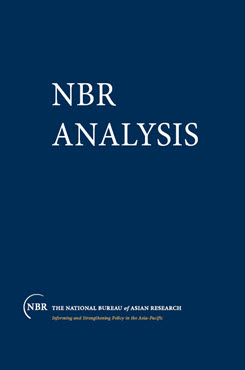NBR Analysis vol. 13, no. 3
Ballistic Missiles and Missile Defense in Asia
Whether used as operational weapons of war or as strategic weapons of deterrence or coercive diplomacy, the development, deployment, and transfer of ballistic missiles pose several concerns for both Asian and U.S. leaders.
An unclassified National Intelligence Council report released on January 9, 2002, noted that the United States is likely to face long–range ballistic missile threats from North Korea and Iran, in addition to China and Russia, by 2015. It also argued that short– and medium–range ballistic missiles already pose a threat to U.S. interests, military forces, and allies in Asia. [1] The development of ballistic missile capabilities, and the proliferation of missiles and missile–related technologies, are an increasingly significant security concern for the United States and many Asian countries. Ballistic missiles are of particular concern because, when armed with conventional high explosive warheads, or especially nuclear, chemical, or biological warheads, they present a combination of capabilities and features unmatched by any other weapon. [2] Such missiles can travel at supersonic speeds, reducing warning time in some cases to a few minutes. They can cover enormous distances, in some cases over 10,000 km, potentially threatening the rear areas of a military theater or even the homeland of an opponent. In many cases missiles can strike a target with a high level of accuracy and with enormous force, often producing devastating damage before an opponent can react. Since ballistic missiles are unmanned, their use does not risk the loss of highly skilled military personnel such as pilots. Furthermore, a missile will not defect or refuse to carry out orders. In addition, ballistic missiles are very difficult to defend against, especially if a potential opponent desires to intercept them before they can strike their intended targets. [3] And unlike airfields or artillery bases, which are large, fixed, vulnerable targets prone to attack, hidden or mobile missiles are hard to find and destroy. Finally, many types of missiles are relatively easy to deploy and operate, especially compared to a trained air force with manned aircraft and a large infrastructure.
Whether used as operational weapons of war or as strategic weapons of deterrence or coercive diplomacy, the development, deployment, and transfer of ballistic missiles pose several concerns for both Asian and U.S. leaders. First, ballistic missiles can increase the sense of vulnerability of key states—including U.S. friends and allies in the Asia Pacific region—and thus raise tensions and undermine stability. A potential aggressor with a significant ballistic missile arsenal might be tempted to resort to greater political or military threats, or to lower the threshold at which it might use force in a crisis. Such a possibility…
[1] National Intelligence Council, Foreign Missile Developments and the Ballistic Missile Threat through 2015, January 9, 2002.
[2] A ballistic missile is rocket-powered during the boost phase of its flight and then travels by its own momentum in or above the atmosphere before it falls to its target with the aid of a guidance system. Ballistic missiles are typically classified by a number of capabilities and characteristics, the first being range: 1) battlefield short range (BSRBM), capable of traveling up to 150 km; 2) short range (SRBM), from 150 km to 1,000 km; 3) medium range (MRBM), from 1,000 km to 3,000 km; 4) intermediate range (IRBM), from 3,000 km to 5,500 km; and 5) intercontinental (ICBM), which can reach targets more than 5,500 km away. See Appendix for additional information on the types and components of ballistic missiles.
[3] “Whether short or long range, a successfully launched ballistic missile has a high probability of delivering its payload to its target compared to other means of delivery,” Report of the Commission to Assess the Ballistic Missile Threat to the United States, July 15, 1998 (hereafter the Rumsfeld Report).


